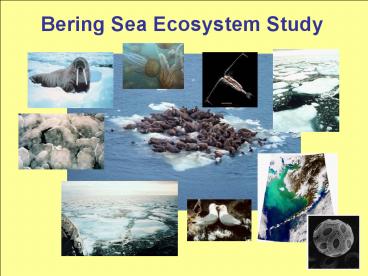Bering Sea Ecosystem Study - PowerPoint PPT Presentation
1 / 22
Title:
Bering Sea Ecosystem Study
Description:
(Investigators: Peter Boveng, John Bengston, Michael Cameron) Emphasis: ice seals. North Pacific Pelagic Seabird Observer Program (Investigators: Kathy Kuletz, ... – PowerPoint PPT presentation
Number of Views:113
Avg rating:3.0/5.0
Title: Bering Sea Ecosystem Study
1
Bering Sea Ecosystem Study
2
Overview
- Focus on the effects of sea ice on
the ecosystem
structure / function
and what the loss of ice might mean - First Competition held Dec. 2005,
- with 6 programs funded in summer
- 2006. 3.5 million US awarded
- Second Competition held Dec. 2006,
- with results announced in Summer
- 2007. 10 million US available
- First Cruise 10 April-12 May 2007,
- in a moderate ice year
- Future Cruises expected in March-
- April and possibly June - July of
- 2008, 2009, and 2010
3
Ice, Wind, Bloom, Copepods
- How is the Disappearance of Sea Ice Affecting
the Bering Sea Ecosystem - Timing and magnitude of the spring bloom
- The fate of the spring bloom water column /
benthos
Spring Ice Retreat Spring Bloom
Zooplankton Predators
Figure Hunt, UW
4
Integrated Bering Sea Ecosystem Study
BASIS FOCI NPCREP AOOS
BSIERP
AFSC NMML PMEL
OPP Arctic Natural Social Sciences
USFWS USGS
5
BEST Cruise 2007
Collaborative Research
33 days April 10 - May 12
Ice-breaker USCGC Healy
Figure Stabeno, NOAA
6
NSF Investigators
Impacts of Sea-ice on the Hydrographic Structure,
Nutrients, and Mesozooplankton
over the Eastern Bering Sea Shelf (Principal
Investigators George Hunt, Phyllis Stabeno, Jeff
Napp) Emphasis hydrographic, nutrients,
phytoplankton, zooplankton The Role of Ice
Melting in Providing Available Iron to the
Surface Water of the
Eastern Bering Sea Shelf (Principal Investigator
Jingfeng Wu) Emphasis iron fertilization
Nitrogen Supply for New Production and its
Relation to Climatic Conditions
on the Eastern Bering Sea Shelf (Principal
Investigators Raymond Sambrotto, Daniel
Sigman) Emphasis productivity
Denitrification and Global Change in Bering Sea
Shelf Sediments (Principal Investigators David
Shull, Allan Devol) Emphasis productivity,
carbon flux to the benthos
7
Other NSF Investigators(not on the cruise)
The Impact of Changes in Sea Ice on the Physical
Forcings of the Eastern Bering Ecosystem
Retrospective Investigation and Future
Projection (Principal Investigators Jinlun
Zhang, Rebecca Woodgate) Emphasis modeling sea
ice extent and thickness Nelson Island Natural
and Cultural Knowledge Project (Principal
Investigators Mark John Ann Fienup-Riordan,
Calista Elders) Emphasis traditional knowledge,
responses to climate change
8
Other Participating Investigators
Ecosystems and Fisheries Oceanography Coordinated
Investigations (EcoFOCI) (Investigators Jeff
Napp (AFSC), Phyllis Stabeno (PMEL)) Emphasis
hydrography, nutrients, plankton, fish
larvae National Marine Mammal Laboratory (NMML)
(Investigators Peter Boveng, John Bengston,
Michael Cameron) Emphasis ice seals North
Pacific Pelagic Seabird Observer
Program (Investigators Kathy Kuletz, David
Irons) Emphasis seabirds Walrus and Ice Seal
Surveys Project overview (Investigators
Carleton Ray, Jerry McCormick-Ray) Emphasis
walrus
9
Inter-disciplinary Research
Spring Ice Retreat Spring Bloom
Zooplankton Predators
10
Many Different Perspectives
On the ice
From the air
From space
Under the ice
11
Cruise Track
- Unimak / Mooring 2
- 70-m isobath transect
- Saint Lawrence line
- Saint Matthew line
- Visit to Pribilof Islands
- Adaptive Sampling
- Shelf - slope transects
- Revisitation SM line
- 70-m isobath transect
- SE Shelf pollock larvae
Figure Stabeno, NOAA
12
Middle Shelf Survey (70-m isobath)
- Fine-scale CTD survey 10 nm
station spacing - Ground-truthing four NOAA - PMEL moorings
(M2, M4, M5, M8) - Two transects in 2007
- early April, early May
- Previous visits
- May 2005
- Sept. 2006
Figure Stabeno, NOAA
13
Middle Shelf Survey
(early April 2007)
SOUTH
NORTH
- Hydrographic front in the central shelf
- Thermocline (20 m depth) to the
south - Warm / fresh water south
- Cool / salty water north
SOUTH
NORTH
Figure Sambrotto, LDEO
14
Middle Shelf Survey
(early April 2007)
SOUTH
NORTH
- Regional difference in the onset of the spring
bloom - Productive waters in the stratified area (south)
- High oxygen saturation concentrations (south)
SOUTH
NORTH
Figure Sambrotto, LDEO
15
Sea Surface Temperature
Warmer Colder
Figure Cokelet, NOAA
16
Sea Surface Salinity
Saltier Fresher
Figure Cokelet, NOAA
17
Surface Chlorophyll Concentration
More Productive Less Productive
Figure Cokelet, NOAA
18
BEST 2007Fluorescence with respect to the Ice
Edge
Image courtesy of R. Sambrotto
19
Cruise Outreach
http//www.pmel.noaa.gov/foci/ice07/ http//w
ww.polartrec.com/best-cruise/overview/
20
Summary
- Cruise Findings
- Bloom initiated in the south
(early
April) - Ice-edge blooms developing
(late April early May) - No sinking carbon to the bottom
- Future BEST Cruises (2008-2010)
- 2007 was a moderate sea ice year
- 4 mid-shelf surveys completed
- May 2005, NOAA, (low ice year)
- April 2007 (moderate ice year)
- May 2007 (moderate ice year)
- Sept. 2006, NOAA, (moderate ice year)
21
BEST Information Sources
- Science Plan, available in Hard Copy at
- Arctic Research Consortium of the U.S. (ARCUS)
- 3535 College Road, Suite 101, Fairbanks, AK
99709 - Phone 907-474-1600 Fax 907-474-1604
- Planning Group. c/o George L. Hunt, Jr.
- School of Aquatic Fishery Sciences
- University of Washington, Seattle
- Email geohunt2_at_u.washington.edu
- Web Site http//www.fish.washington.edu/best
22
(No Transcript)































